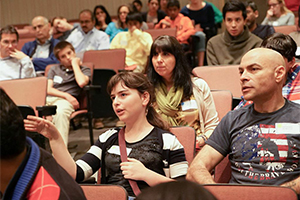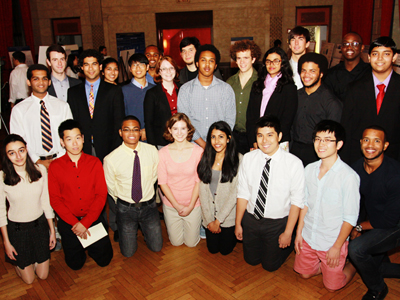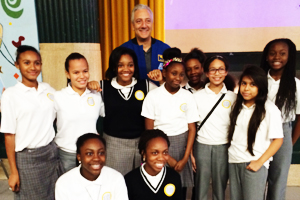Inspiring Tomorrow's Engineers
Just as Columbia engineers daily take on the world’s most critical technical challenges, the Engineering School’s slate of youth outreach programs is also helping engineer the profession’s next generation.

Participants at the Science & Technology Family Academic Program with Johns Hopkins Center for Talented Youth.
A team of Engineering faculty—including lead coordinator Assistant Professor Javad Lavaei, Professor Sunil Agrawal, and Assistant Professor Christine Hendon—joined a small army of graduate and undergraduate students Sept. 20 to instruct and inspire promising kids, grades 7 through 10, on how technology is continuously transforming modern life. An array of specially-designed projects, workshops, presentations, and demonstrations explored intriguing problems including medical robotics, the multiple scales of civil engineering, the Internet’s use of optical communication, energy and power, contemporary integrated circuits and systems, biomedical optics, and discrete mathematics.
“Giving young students the opportunity both to meet those who are conducting cutting edge research and, more importantly, the chance to get hands-on experience grappling with scientific problems, ignites interest at a critical stage in students' academic development, helps them bring what is possible in their own futures into focus, and delineates the next steps in their STEM educations,” said Emily Ford, director of Outreach Programs at the School. “Through our outreach programs, Columbia Engineering is shaping some of the brightest minds into the next generation's problem solvers.”

Student participants in the Summer Research Symposium.
In facilities across Columbia’s Morningside campus, young students involved in the national Johns Hopkins Center for Talented Youth Program interfaced with professional engineers, scientists, and researchers—in addition to working closely with talented peers and their parents. The program, produced in collaboration with Johns Hopkins University’s Science and Technology Series, engages students with the exciting range of possibilities across the spectrum of STEM fields.
One student, a seventh-grader named Chandini Singla, wrote Columbia University President Lee Bollinger to express her appreciation. “I wanted to thank you because it was very nice of you to share your school and open up a whole new world for me,” she wrote. “[The program] inspired me to solve problems so I that I could help people all over the world have nicer lives than before.”
Over the summer, Columbia’s Department of Mechanical Engineering partnered with the Engineering School’s Outreach Programs and colleagues from Columbia Secondary School for Math, Science, and Engineering (CSS) to pilot the new Young Scholars Program to provide local underserved and underrepresented high school students with hands-on research and design opportunities. Led by Mechanical Engineering Professor James Hone, with support from Agrawal and Professor Jeffrey Kysar, the initiative welcomed students into Columbia Engineering’s labs to learn a variety of techniques and contribute to state of the art research from principal investigators and current Engineering students.

Michael Massimino, professor of professional practice and former NASA astronaut, has visited several local schools to talk about his remarkable experience.
The high school students logged detailed notebooks on their lab work and engineering design efforts in materials science, robotics, and physics, producing tangible artifacts and analyzing production feasibility. They presented their findings at a Master Class Sept. 18 with faculty advisors, graduate students, and other mentors. And, later, students presented posters on their work at the annual Summer Research Symposium held in October. Hone also gave students the opportunity to continue their research into the academic year.
“It was a great experience that really allowed me to learn how engineers think,” said participant Nicholas Pape. Another student, Nafassho Nafasshoev, remarked, “The most exciting part was that the knowledge and experience were diverse and helped me establish more future goals, more specific material to learn.”
The pilot program is part of the Engineering School’s continuing efforts to increase the interest and opportunities in STEM fields at the high school level, promote the diversity of STEM education, and highlight the variegated pathways to STEM careers.
Programs have continued into the academic year. On October 4th, Columbia’s chapter of Engineers Without Borders held a high school conference on sustainable development and STEM through the lens of sustainability. Students convened for workshops from professors, professionals, and Engineering students on microfinance, engineering for social change, leadership, and related careers. Throughout the semester, Michael Massimino, professor of professional practice in Mechanical Engineering and former NASA astronaut, has visited several local schools to talk about his remarkable experience. Massimino’s visits are part of an expanding new series called “Science Speaks,” that welcomes faculty and alumni to share engineering with kids.
With numerous events and initiatives scheduled in months to come, the Engineering School’s ambitious series of outreach programs promises to expand tomorrow’s pool of rising engineers, at Columbia and beyond.
